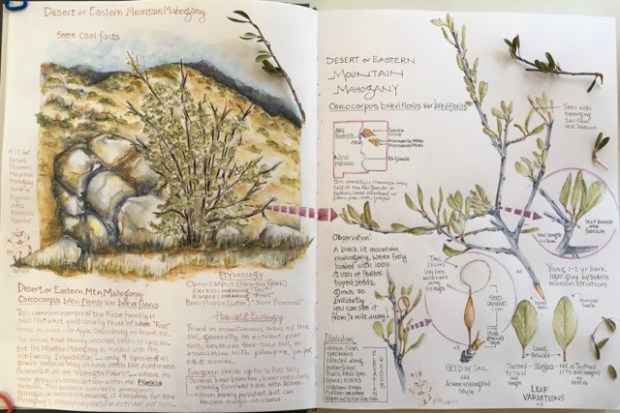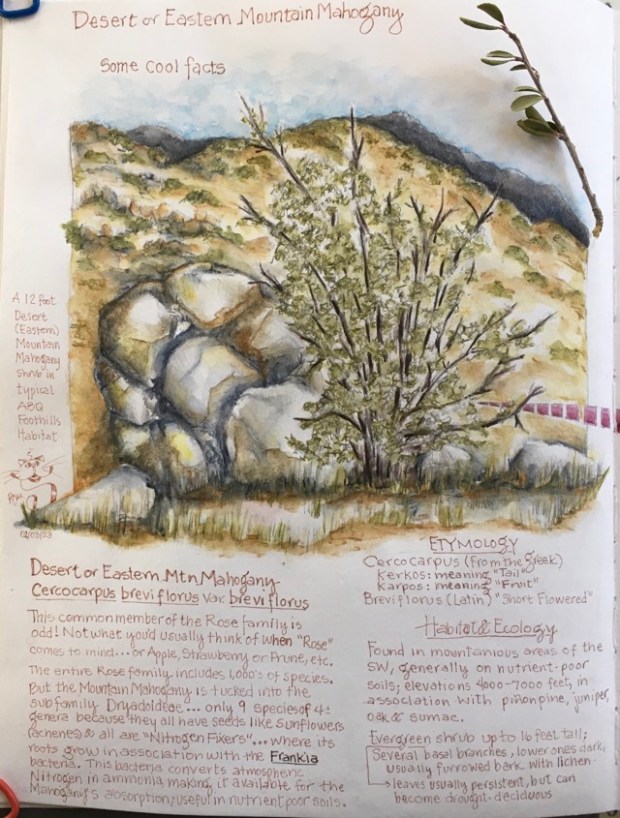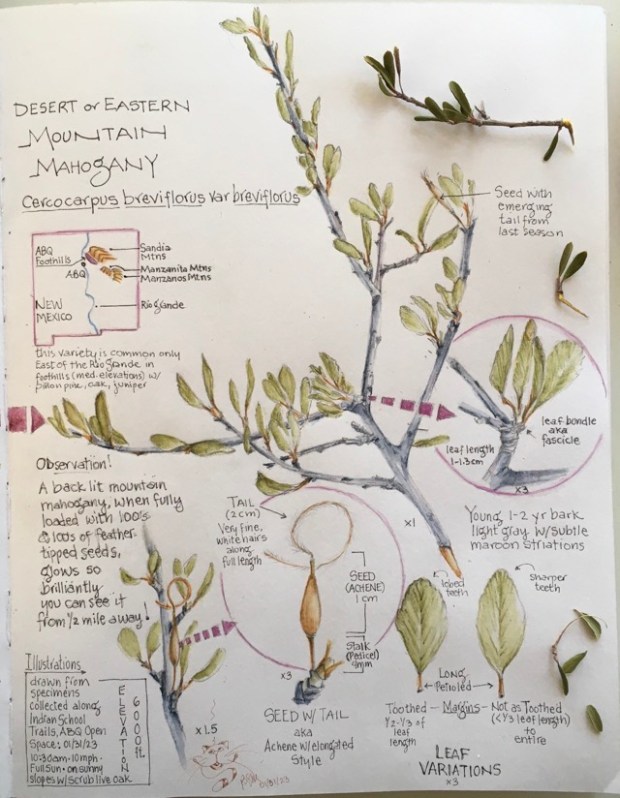
February 8, 2023
The Desert (Eastern) Mountain Mahogany is a very branchy shrub commonly found in the mid-elevation foothills of the Sandia, Manzanita, and Manzano Mountains east of the Rio Grande River in central New Mexico. This species’ formal and very appropriate name, Cercocarpus breviflorus variety breviflorus, comes from both Greek (kerkos: tail; karpos: fruit) and Latin (brevi: short; florus: flowered). As a matter of fact, the 9 species of the genus Cercocarpus all have long feathery tails that twist and turn from the tip of a single fruit, called an achene (like a sunflower seed).
So why is this species odd?
Well, the fruit, for one reason. Most of the thousands of rose family members have fruits called a hip (rose), pome (apple), drupe (prune), or aggregate (strawberry). And even though the strawberry is composed of numerous miniature achenes, it’s the single achene found in the mountain mahoganies that’s unusual to the family.
To further emphasize the oddness of the Cercocarpus genera, all of its 9 species has a symbiotic relationship with a bacteria called Frankia. And that’s an unusual characteristic of the rose family, which moved Cercocarpus and 4 other genera into the subfamily Dryadoideae. That’s all a bit technical when it comes to plant classification, and kind of skips the real reason why the Frankia bacteria is important to the survival of Desert Mountain Mahogany. Nitrogen Fixation!
Read on to learn more …..
Fixing Nitrogen
Nitrogen-fixing bacteria, like Rhizobium (specific in legumes) and Frankia (specific to Cercocarpus and other genera) are able to form a symbiotic (beneficial to each species) relationship with the roots of certain plants. In the case of a Frankia infection, the filaments of the bacteria enter the host plant through its root hairs and form nodules. It’s inside these nodules where the bacteria, with the help of an enzyme, convert atmospheric nitrogen into ammonia, a form of nitrogen that’s readily absorbed by the host plant. The host plant benefits greatly as it can then grow in nutrient poor soils, the bacteria are able to multiply and spread throughout the healthy root system, developing more nodules and fixing more nitrogen, which the host plants absorbs, etc., etc. It’s a win-win scenario that’s been going on for millennia, and has enabled these bacteria-receptive plant species to colonize disturbed lands where soils are poor or even lacking nutrition.

That puts this Desert (Eastern) Mountain Mahogany in a new-to-me perspective. Thanks to Frankia, the mountain mahogany may have been able to establish themselves hundreds of millions of years ago following the major uplift of Sandia Mountain, helping to stabilize the highly erosive granitic soils for other plants to grow. Perhaps having mountain mahogany growing throughout the foothills not only encouraged today’s diversity of plant species, but has slowed the downhill movement of gazillions of granite pebbles, making for more stable hiking trails! Hmmmmm! Now that’s interesting.

Western Sheepmoth (Hemileuca eglanterina)
One more interesting thing …… while searching for beneficial wildlife/mountain mahogany associations (deer absolutely love browsing on the leaves), I learned the Western sheepmoth, that flies like a grounded butterfly, is supposed to be a frequent visitor. The adult moths don’t feed, but they do deposit eggs at the base of the plants and the caterpillars can be found munching on tender leaves. Although the mountain mahogany population looks healthy in this area, I don’t recall seeing any of these moths or their “cats.” Something to start searching for this coming Spring, which is right around the corner.
What’s nature displaying in your world right now?

Such detail!
LikeLiked by 1 person
Ha! Can’t help myself. Thanks Jean!
LikeLike
How interesting that when backlit you can see the glow from 1/2 mile away! I sure would like to see one of the sheep moths. Hope you will see one in the spring!
LikeLiked by 1 person
The glow is unbelievable. Last summer there were hillsides of fully seeded mountain mahogany and at sunrise, they lit up in a spectacular display of brilliance! I also hope to find at least one sheepmoth. They are quite beautiful, and often mistaken for a butterfly! Thanks for the comments Karen!
LikeLiked by 1 person
Love your work, most impressive. 👍 🙌
LikeLike
Thank you so much for the comments, Denzil. And thanks especially for following!
LikeLiked by 1 person
Happy to follow interesting blogs!
LikeLiked by 1 person
I want to see a glowing plant, and the moth!!
LikeLike
Thanks!
LikeLike